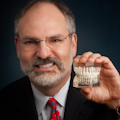Are you telling, selling, or informing?
We all have so much knowledge, and we want to tell our patients what we know. We have invested so much money in technology, which we have been told we need to sell to our patients: digital x-rays, digital images, and digital cosmetic makeovers. But I have found that the technology we have should only be used to inform the patient of the information that we have already gathered.
Are you telling, selling, or informing?
Let me explain with a story. Three umpires are sitting around a table talking about their favorite subject, baseball. One is a rookie, one has 10 years of calling balls and strikes, and the other has been retired for a couple of years. Picture the young guy, full of excitement and animation; the middle-aged guy, trying to give advice to the younger one; and the older guy leaning back, taking it all in, and smiling broadly. The young guy yells, “I call them like they are!” The middle-aged guy, in a louder voice, says, “I call them like I see them!” The retired ump, with years of experience, says in a very low voice so the other guys have to lean forward to hear, “They are nothing until I call them.” The other two are shocked into silence, and then nod in agreement. Unless the information is spoken, there is no call.
More from the author ... Are you prepared when your patient says yes to treatment?
So, how does the story relate to our daily dental lives? Think about what these people are saying, but also think about the differences in their experiences. We all went to dental school and we all have training—some better than others—but basically we all take the same exams and the same boards. Many of us go on to have further training, and some become specialists in different aspects of dentistry.
How do you call them?
Think about where you are now in your career. Are you a rookie, midcareer, or approaching the last years of your career? Do you call them like they are because you have so much information and things are black and white? Or has being behind the chair for a while shown you that how you see them is how things will be managed because instant replay will prove you right? Or, because you have seen so much and have so much experience and remember so many interactions, do you realize that they are nothing until you call them?
What can we learn from this story in the dental world? I always say that there is a body attached to the teeth. Those bodies come with all sorts of experiences, concerns, and emotions. We have to understand that we are in the relationship business. So, let’s put it in a diagnostic point of view.
Building relationships
A new patient comes in with an ugly acrylic covering a gold front crown. Her chief complaint is that the crown feels rough on the back, the edge is broken off, and her tongue is sore. She was not referred by anyone and had called a couple of offices, and no one else would see her since she wasn’t a patient of record. Always being available for emergency patients is a wonderful practice builder.
Let’s think about the three umpires and pretend they are dentists.
More from the author ... The worst thing versus the best things for dentists and patients
The young dentist (“call them like they are”) comes quickly into the room without introducing himself, does his exam, and says, “Who did this ugly front crown for you? It needs to be replaced because it is no good. How long has it been there?” The patient replies, “It was the last dental procedure my father did for me just before he died, and as for how old it is, I think Truman was president then. Do you think you could just patch it up for me for the time being?”
The middle-aged dentist (“call them like I see them”) comes into the room, already knowing what insurance coverage the patient has, and introduces himself to the patient, who is already lying down, with an x-ray, video camera shot, an iTero scan, and signed consent form. The middle-aged dentist says, “We know you need a new crown because nothing will bond to the gold. It is X dollars, with the insurance company paying X, and I can start it today. If you want to have a great smile, as you can see in the before-and-after scan, we can really improve it and make you look younger. If my treatment coordinator makes financial arrangements with you, is there any reason why you cannot do this today?”
The older dentist (“they are nothing until I call them”) comes into the room with the patient sitting up and sits down at the same level as the patient. She says, “I understand you are having a problem with your front tooth. So what is happening?” With that, the patient explains that the tooth is rough and makes her tongue sore. The dentist asks, “How long have you had this crown?” She knows that it has to be at least 40 years old because acrylic to gold stopped around that time. The patient tells the dentist the story of how her dad made the crown for her many years ago. Now the patient is asked, “May we take a necessary x-ray of your crown that your dad made for you?”
You can see what is happening here. Relationships are built on understanding and trust. And until you call them, they are nothing. After the x-ray and exam, the older dentist suggests a quick bond repair to tide the patient over, and it is suggested that a new crown may be required. “But before that is done, perhaps you would like to see one of our experienced hygienists [who will be introduced to the patient before she leaves] to work with you on getting your teeth and gums a little healthier before investing in your smile. Is that something that you are interested in? I can make a good temporary fix to tide you over.” Nothing is done until the dentist calls for it with the consent of the patient. The dentist offers to do the repair at no charge, as “a favor to your dad, who did a great job 40 years ago.”
The repair takes about 10 minutes, and then the patient is brought to the front desk. The front desk assistant says, “I understand from the dentist that you have some things to think about. How would you like to proceed?” The patient has been informed, and she says, “I need my teeth cleaned, and I need to work on my whole smile and do what needs to be done.” It is really all about finding the balance. Have a productive month.
Editor's note: This article appeared in the January 2024 print edition of Dental Economics magazine. Dentists in North America are eligible for a complimentary print subscription. Sign up here.
Jeffrey C. Hoos, DMD, a 1978 graduate of the Tufts University School of Dental Medicine, started his private practice as a one-operatory walk-up and grew it to a four-doctor practice with 25 staff members. He lectures on innovative techniques that balance the art, science, and business of dentistry. He is one of the first general dentists to be Brånemark certified for implant placement, and his office has become a teaching center for restorative and implant dentistry. Contact him at [email protected].
About the Author
Jeffrey C. Hoos, DMD
Jeffrey C. Hoos, DMD, a 1978 graduate of the Tufts University School of Dental Medicine, started his private practice as a one-operatory walk-up and grew it to a four-doctor practice with 25 staff members. He lectures on innovative techniques that balance the art, science, and business of dentistry. He is one of the first general dentists to be Brånemark certified for implant placement, and his office has become a teaching center for restorative and implant dentistry. Contact him at [email protected].

